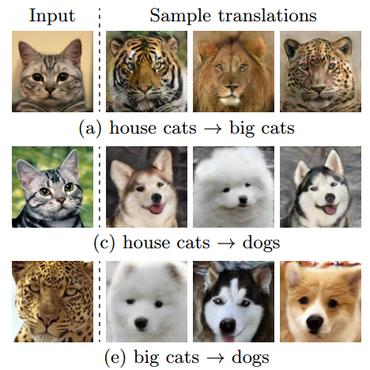Search Results for author: Xinyang Li
Found 12 papers, 8 papers with code
NeRF-DetS: Enhancing Multi-View 3D Object Detection with Sampling-adaptive Network of Continuous NeRF-based Representation
no code implementations • 22 Apr 2024 • Chi Huang, Xinyang Li, Shengchuan Zhang, Liujuan Cao, Rongrong Ji
As a preliminary work, NeRF-Det unifies the tasks of novel view synthesis and 3D perception, demonstrating that perceptual tasks can benefit from novel view synthesis methods like NeRF, significantly improving the performance of indoor multi-view 3D object detection.
ICHPro: Intracerebral Hemorrhage Prognosis Classification Via Joint-attention Fusion-based 3d Cross-modal Network
2 code implementations • 17 Feb 2024 • Xinlei Yu, Xinyang Li, Ruiquan Ge, Shibin Wu, Ahmed Elazab, Jichao Zhu, Lingyan Zhang, Gangyong Jia, Taosheng Xu, Xiang Wan, Changmiao Wang
Intracerebral Hemorrhage (ICH) is the deadliest subtype of stroke, necessitating timely and accurate prognostic evaluation to reduce mortality and disability.
VRMN-bD: A Multi-modal Natural Behavior Dataset of Immersive Human Fear Responses in VR Stand-up Interactive Games
1 code implementation • 22 Jan 2024 • He Zhang, Xinyang Li, Yuanxi Sun, Xinyi Fu, Christine Qiu, John M. Carroll
Understanding and recognizing emotions are important and challenging issues in the metaverse era.
GCS-ICHNet: Assessment of Intracerebral Hemorrhage Prognosis using Self-Attention with Domain Knowledge Integration
1 code implementation • 8 Nov 2023 • Xuhao Shan, Xinyang Li, Ruiquan Ge, Shibin Wu, Ahmed Elazab, Jichao Zhu, Lingyan Zhang, Gangyong Jia, Qingying Xiao, Xiang Wan, Changmiao Wang
Intracerebral Hemorrhage (ICH) is a severe condition resulting from damaged brain blood vessel ruptures, often leading to complications and fatalities.
Hybrid NOMA assisted Integrated Sensing and Communication via RIS
no code implementations • 12 Sep 2023 • Wanting Lyu, Yue Xiu, Xinyang Li, Songjie Yang, Phee Lep Yeoh, Yonghui Li, Zhongpei Zhang
Furthermore, the trade-off between sensing and communication is analyzed and demonstrated in the simulation results.
StreetSurf: Extending Multi-view Implicit Surface Reconstruction to Street Views
1 code implementation • 8 Jun 2023 • Jianfei Guo, Nianchen Deng, Xinyang Li, Yeqi Bai, Botian Shi, Chiyu Wang, Chenjing Ding, Dongliang Wang, Yikang Li
We present a novel multi-view implicit surface reconstruction technique, termed StreetSurf, that is readily applicable to street view images in widely-used autonomous driving datasets, such as Waymo-perception sequences, without necessarily requiring LiDAR data.
Monitoring the evolution of dimensional accuracy and product properties in property-controlled forming processes
no code implementations • 31 May 2023 • Sophie Charlotte Stebner, Juri Martschin, Bahman Arian, Stefan Dietrich, Martin Feistle, Sebastian Hütter, Rémi Lafarge, Robert Laue, Xinyang Li, Christopher Schulte, Daniel Spies, Ferdinand Thein, Frank Wendler, Malte Wrobel, Julian Rozo Vasquez, Michael Dölz, Sebastian Münstermann
However, a closed-loop control that can adjust and manipulate the process actuators according to the required product properties of the component will lead to a considerable increase in efficiency of the processes regarding resources and will decrease postproduction of the component.
MGR: Multi-generator Based Rationalization
1 code implementation • 8 May 2023 • Wei Liu, Haozhao Wang, Jun Wang, Ruixuan Li, Xinyang Li, Yuankai Zhang, Yang Qiu
Rationalization is to employ a generator and a predictor to construct a self-explaining NLP model in which the generator selects a subset of human-intelligible pieces of the input text to the following predictor.
Sensing-Assisted Receivers for Resilient-By-Design 6G MU-MIMO Uplink
no code implementations • 14 Feb 2023 • Vlad C. Andrei, Xinyang Li, Ullrich J. Mönich, Holger Boche
We address the resilience of future 6G MIMO communications by considering an uplink scenario where multiple legitimate transmitters try to communicate with a base station in the presence of an adversarial jammer.
Image-to-image Translation via Hierarchical Style Disentanglement
1 code implementation • CVPR 2021 • Xinyang Li, Shengchuan Zhang, Jie Hu, Liujuan Cao, Xiaopeng Hong, Xudong Mao, Feiyue Huang, Yongjian Wu, Rongrong Ji
Recently, image-to-image translation has made significant progress in achieving both multi-label (\ie, translation conditioned on different labels) and multi-style (\ie, generation with diverse styles) tasks.
 Disentanglement
Disentanglement
 Multimodal Unsupervised Image-To-Image Translation
+1
Multimodal Unsupervised Image-To-Image Translation
+1
Keypoint Autoencoders: Learning Interest Points of Semantics
1 code implementation • 11 Aug 2020 • Ruoxi Shi, Zhengrong Xue, Xinyang Li
Understanding point clouds is of great importance.
Attribute Guided Unpaired Image-to-Image Translation with Semi-supervised Learning
1 code implementation • 29 Apr 2019 • Xinyang Li, Jie Hu, Shengchuan Zhang, Xiaopeng Hong, Qixiang Ye, Chenglin Wu, Rongrong Ji
Especially, AGUIT benefits from two-fold: (1) It adopts a novel semi-supervised learning process by translating attributes of labeled data to unlabeled data, and then reconstructing the unlabeled data by a cycle consistency operation.


